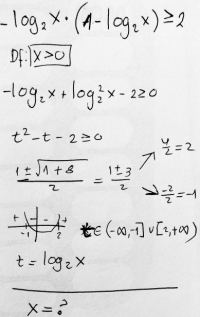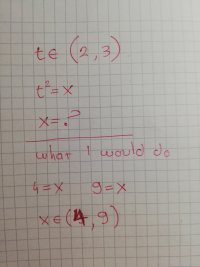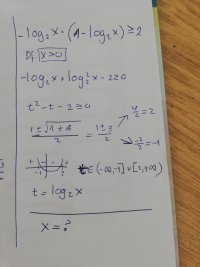You are using an out of date browser. It may not display this or other websites correctly.
You should upgrade or use an alternative browser.
You should upgrade or use an alternative browser.
How to solve this equation
- Thread starter Loki123
- Start date
Dr.Peterson
Elite Member
- Joined
- Nov 12, 2017
- Messages
- 16,087
You evaluated x at the endpoints of the interval (domain), to find the range. This is sufficient in this case because the function [imath]x(t)=t^2[/imath] is monotonically increasing on that interval. It would not be valid for other functions (e.g. [imath]x = (t-2)(t-3)[/imath]) or other intervals (e.g. [imath][-3,3][/imath]).So if i have something like this, where t is defined by an interval and t defines x. How do I determine x? My way is shown, I get correct answers with it, but is it any good? View attachment 30858
You can see all this by graphing the functions.
i have no idea what class/topic this is. This just came across my mind so I though I'd ask. I did post my way but perhaps it's too short to understand. Basically I'd take end points and apply them into equation and put them as end points of x interval.You posted your answer, but not "your way". How did you obtain your answer? What class/topic is this?
okay, so how do you suggest I solve it?You evaluated x at the endpoints of the interval (domain), to find the range. This is sufficient in this case because the function [imath]x(t)=t^2[/imath] is monotonically increasing on that interval. It would not be valid for other functions (e.g. [imath]x = (t-2)(t-3)[/imath]) or other intervals (e.g. [imath][-3,3][/imath]).
You can see all this by graphing the functions.
Dr.Peterson
Elite Member
- Joined
- Nov 12, 2017
- Messages
- 16,087
In general (that is, for any function you might be given), graph the function over the specified interval!okay, so how do you suggest I solve it?
Sometimes it will require finding minima and maxima. In fact, one could argue that this is largely a question of finding absolute maximum and minimum over an interval, which in general is a calculus problem.
For this particular question, with a simple quadratic function, you just need knowledge of the behavior of quadratic functions (e.g. the location of the vertex). It is the fact that your restricted domain does not contain the vertex that makes your simple approach valid.
What you're really saying is that this didn't come from a class at all, so there is no specific context, and you were just asking out of curiosity.i have no idea what class/topic this is. This just came across my mind so I though I'd ask.
It's worth knowing that it is easy to make up a question that is beyond what you have learned (or beyond the level you thought it would be, in this case algebra). Extending any question to more complicated cases brings the possibility of even creating an unsolvable problem.
This came up in a few exercises of all sorts I just thought this would be enough to represent my problem. When I get another problem like this I'll post it here.In general (that is, for any function you might be given), graph the function over the specified interval!
Sometimes it will require finding minima and maxima. In fact, one could argue that this is largely a question of finding absolute maximum and minimum over an interval, which in general is a calculus problem.
For this particular question, with a simple quadratic function, you just need knowledge of the behavior of quadratic functions (e.g. the location of the vertex). It is the fact that your restricted domain does not contain the vertex that makes your simple approach valid.
What you're really saying is that this didn't come from a class at all, so there is no specific context, and you were just asking out of curiosity.
It's worth knowing that it is easy to make up a question that is beyond what you have learned (or beyond the level you thought it would be, in this case algebra). Extending any question to more complicated cases brings the possibility of even creating an unsolvable problem.
D
Deleted member 4993
Guest
You have one positive value and one negative value for 'x'.View attachment 30915
Not a geometric question, but it's the example of what I described.
't' is square root of 'x'.
If 't' is in real domain - only positive value of 'x' should be considered.
But how do I get those positive values? Do I just use end points like I usually would?You have one positive value and one negative value for 'x'.
't' is square root of 'x'.
If 't' is in real domain - only positive value of 'x' should be considered.
D
Deleted member 4993
Guest
I had lost track of the original problem. You started with (response #1)But how do I get those positive values? Do I just use end points like I usually would?
x = t2 ..........................................................................(1)
then you switched to (response #8)
t = log2(x) → x = 2t ......................(2)
About which expression are you having questions ?
in the first one I explained my question, I said then that when I find a similar exercise I will post it to explain better where I am confused. The second is a problem I want help with.I had lost track of the original problem. You started with (response #1)
x = t2 ..........................................................................(1)
then you switched to (response #8)
t = log2(x) → x = 2t ......................(2)
About which expression are you having questions ?
Dr.Peterson
Elite Member
- Joined
- Nov 12, 2017
- Messages
- 16,087
So this is your work:

You haven't actually stated what the problem is; you seem to be calling the LHS "f" and saying its domain is x>0, but ultimately the problem appears to be to solve the inequality for x. You made a substitution and found that [imath]t\le -1[/imath] or [imath]t\ge 2[/imath]. Now you can just reverse the substitution and say that [imath]\log_2(x)\le -1[/imath] or [imath]\log_2(x)\ge 2[/imath]. Solve each of those inequalities, and you have the solution to the original inequality in x. And since the log is monotonic increasing, there is no difficulty in this step. (See my #3.)

You haven't actually stated what the problem is; you seem to be calling the LHS "f" and saying its domain is x>0, but ultimately the problem appears to be to solve the inequality for x. You made a substitution and found that [imath]t\le -1[/imath] or [imath]t\ge 2[/imath]. Now you can just reverse the substitution and say that [imath]\log_2(x)\le -1[/imath] or [imath]\log_2(x)\ge 2[/imath]. Solve each of those inequalities, and you have the solution to the original inequality in x. And since the log is monotonic increasing, there is no difficulty in this step. (See my #3.)
Before we get totally lost, I want to reiterate what Dr. Peterson said.
Evaluating at just the endpoints will not in general solve your problem.
Here is a simple example.
Given the domain [-10, 15], what is the range of f(x) = x^2 - 64.
f(-10) = 36 and f(15) = 161.
If you say the range is [36, 161], you will be grossly wrong . 0 is in the indicated domain, and f(0) = - 64.
You have picked problems where the endpoints method works, but the method does not work generally.
Evaluating at just the endpoints will not in general solve your problem.
Here is a simple example.
Given the domain [-10, 15], what is the range of f(x) = x^2 - 64.
f(-10) = 36 and f(15) = 161.
If you say the range is [36, 161], you will be grossly wrong . 0 is in the indicated domain, and f(0) = - 64.
You have picked problems where the endpoints method works, but the method does not work generally.


